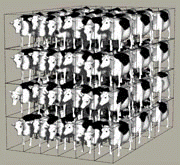Animal Science, Department of

World Congress on Genetics Applied to Livestock Production: 3rd (1986)
Date of this Version
1986
Abstract
Merinos are the predominant sheep breed in Australia, accounting-for about 76% of a total of 150m. Approximately 197,000 Merino rams are sold annually, of which 157,000 are horned and 40,000 are polled.
The Australian Merino is above all a producer of premium quality white wool. The major determinant of wool income is weight, but the price per kilogram is influenced mainly by fibre diameter.
Recording in Merino stud flocks is minimal. Sires are sometimes identified but dam identities are not routinely recorded. Neither are required for registration purposes. Subjective grading of breeding stock is still the main selection criterion, but there is an increasing emphasis on wool testing data.
Several past attempts to design and establish recording services aimed at flocks with some pedigree information have been largely ignored by Merino breeders. However, successful testing services based on fibre diameter measurement and either greasy or clean fleece weights have been set up by some of the State Departments of Agriculture, the Australian Wool Testing Authority, the School of Wool and Pastoral Sciences (Univ. of N.S.W.) and by private consultants and are well supported. WOOLPLAN is an attempt to rationalize and integrate testing services and extend them to incorporate the recording requirements of studs producing rams for commercial flocks in which wool is an important, though not the sole, source of income.


Comments
Published in 3rd World Congress on Genetics Applied to Livestock Production, edited by Gordon E. Dickerson and Rodger K. Johnson, 4 vols. (Lincoln: University of Nebraska Institute of Agriculture and Natural Resources, 1986). Copyright © 1986 Board of Regents University of Nebraska.